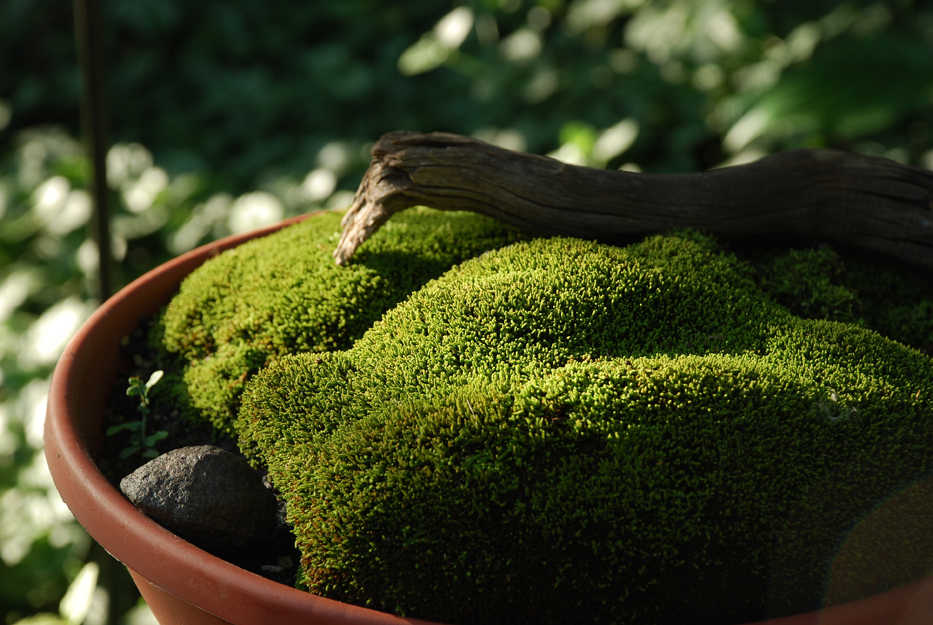J. Paul Moore, who owned a garden center in Tennessee for over 30 years, can’t count the number of times people asked him how to kill moss.
He and other experts, however, say moss deserves more respect, as a versatile and beautiful addition to any garden.
“It’s stunning in the winter when everything else is dormant and dull. It’s like a little emerald island,” says Moore, who’s got an entire moss lawn. “It changes with atmospheric conditions — it’s ever-changing.”
And it looks better than his grass lawn did in Nashville’s hot dry summers, he says.
Moss provides a variety of shapes and textures, and can work in everything from a container to a whole lawn, like Moore’s.
“Mosses offer year-round green,” says Annie Martin, author of “The Magical World of Moss Gardening” (Timber Press, 2016). It thrives in a surprising range of climates; she once harvested some moss off a hot tin roof in June and found it to be a species that also grows in Antarctica.
Some lessons on how to garden with moss can be found in Japan, where it is more valued. Dale Sievert has created Japanese-style gardens at his home in Waukesha, Wisconsin, and for public gardens in Wisconsin and Chicago.
But this type of formal garden with great expanses of moss wasn’t actually what he found most interesting when he visited Japan. Rather, it was how often moss was used in private gardens along city streets, in front of businesses and homes — just a couple square feet in a planter, or the space between a sidewalk and a building.
“That’s how they garden with moss, in these little tiny spots,” he says.
So, he says, start small. One possibility: Instead of using mulch, plant moss to cover the ground under a perennial that’s bare at the bottom and bigger on top. Or start even smaller: in a flowerpot. Sievert has about 300 containers planted with moss, where they thrive even in the Wisconsin winter.
Another way to start is to encourage moss where it’s already growing in your yard. That’s what Moore did when he decided to give up trying to grow grass in an area where it refused to thrive. Within two or three years, the moss had covered about 5,000 square feet.
“The first thing people ask is, can you walk on it? What does it feel like on your bare feet?” he says. “I say, ‘Take your shoes off!’”
Although heavy traffic will wear it down, and you wouldn’t want kids or dogs roughhousing on it, moss actually likes to be walked on.
If you want to encourage moss to spread, remove weeds and grass, provide moisture and keep it clear of debris; don’t let leaves and sticks pile up. You can also move it around to where you want it: Mosses don’t grow from seed, but they do spread from any part of the plant.
“They can grow from a leaf or a stem or rhizoid,” says Martin. “Just cut them up or tear them up.”
You can also buy moss to plant. Martin sells many species online from her moss nursery.
“I have mats that roll out like a green carpet,” she says. “They’re great for people who don’t have patience.”
Moss will go dormant if it’s not watered, but uses less water than most other garden plants. Unlike them, it has no roots. The root-like structures you see when you pull up a clump of moss are called rhizoids. “Their only purpose is to hold it to the surface,” says Martin.
Since moss takes in water and nutrients through its leaves instead of through roots, several light waterings are better than a long drench.
This also means that planting is easy: You don’t need to dig holes or improve soil.
“You can use nutrient-poor soil where nothing else will grow and do nothing to prep it in advance except clear the debris away,” Martin says.
Another advantage: Moss doesn’t need fertilizer or pesticides. The same substances that keep moss from freezing in winter also taste bad to insects.
But to its fans, moss’ best feature is its unique charm.
“When you talk about moss to anybody, they smile. It’s like the plant equivalent of a teddy bear,” says Moore. “It conjures up elves in the forest.”

